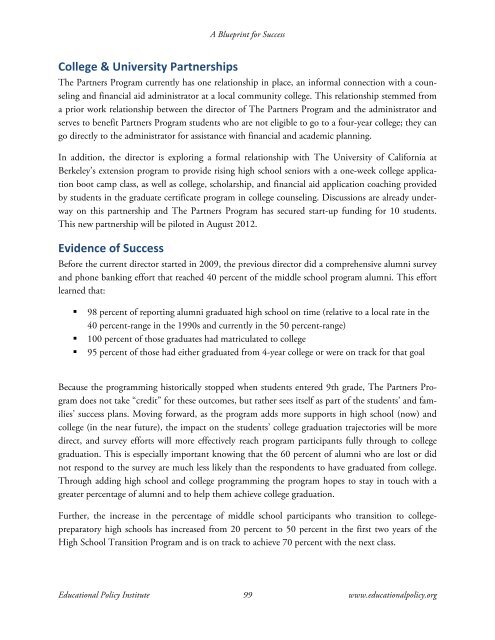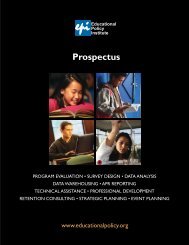A BluePrint for Success: Case Studies of Successful - Educational ...
A BluePrint for Success: Case Studies of Successful - Educational ...
A BluePrint for Success: Case Studies of Successful - Educational ...
Create successful ePaper yourself
Turn your PDF publications into a flip-book with our unique Google optimized e-Paper software.
College & University Partnerships<br />
A Blueprint <strong>for</strong> <strong>Success</strong><br />
The Partners Program currently has one relationship in place, an in<strong>for</strong>mal connection with a counseling<br />
and financial aid administrator at a local community college. This relationship stemmed from<br />
a prior work relationship between the director <strong>of</strong> The Partners Program and the administrator and<br />
serves to benefit Partners Program students who are not eligible to go to a four-year college; they can<br />
go directly to the administrator <strong>for</strong> assistance with financial and academic planning.<br />
In addition, the director is exploring a <strong>for</strong>mal relationship with The University <strong>of</strong> Cali<strong>for</strong>nia at<br />
Berkeley’s extension program to provide rising high school seniors with a one-week college application<br />
boot camp class, as well as college, scholarship, and financial aid application coaching provided<br />
by students in the graduate certificate program in college counseling. Discussions are already underway<br />
on this partnership and The Partners Program has secured start-up funding <strong>for</strong> 10 students.<br />
This new partnership will be piloted in August 2012.<br />
Evidence <strong>of</strong> <strong>Success</strong><br />
Be<strong>for</strong>e the current director started in 2009, the previous director did a comprehensive alumni survey<br />
and phone banking ef<strong>for</strong>t that reached 40 percent <strong>of</strong> the middle school program alumni. This ef<strong>for</strong>t<br />
learned that:<br />
98 percent <strong>of</strong> reporting alumni graduated high school on time (relative to a local rate in the<br />
40 percent-range in the 1990s and currently in the 50 percent-range)<br />
100 percent <strong>of</strong> those graduates had matriculated to college<br />
95 percent <strong>of</strong> those had either graduated from 4-year college or were on track <strong>for</strong> that goal<br />
Because the programming historically stopped when students entered 9th grade, The Partners Program<br />
does not take “credit” <strong>for</strong> these outcomes, but rather sees itself as part <strong>of</strong> the students’ and families’<br />
success plans. Moving <strong>for</strong>ward, as the program adds more supports in high school (now) and<br />
college (in the near future), the impact on the students’ college graduation trajectories will be more<br />
direct, and survey ef<strong>for</strong>ts will more effectively reach program participants fully through to college<br />
graduation. This is especially important knowing that the 60 percent <strong>of</strong> alumni who are lost or did<br />
not respond to the survey are much less likely than the respondents to have graduated from college.<br />
Through adding high school and college programming the program hopes to stay in touch with a<br />
greater percentage <strong>of</strong> alumni and to help them achieve college graduation.<br />
Further, the increase in the percentage <strong>of</strong> middle school participants who transition to collegepreparatory<br />
high schools has increased from 20 percent to 50 percent in the first two years <strong>of</strong> the<br />
High School Transition Program and is on track to achieve 70 percent with the next class.<br />
<strong>Educational</strong> Policy Institute 99 www.educationalpolicy.org




